
Steamboat People: Captain LaVerrier Cooley
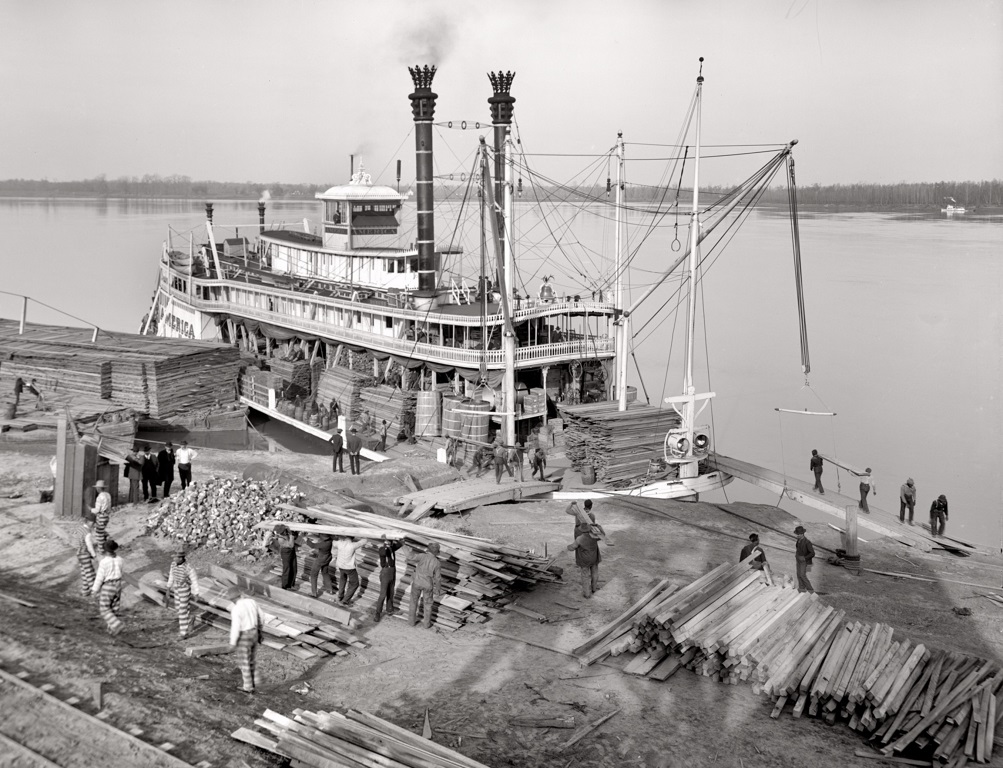
Captain Cooley's AMERICA at Angola, 1910
Cropped high angle photo taken in 1910 of Captain Cooley's AMERICA at Angola Landing, adjacent to Louisiana State Prison Farm on the Mississippi River. The AMERICA was one of the most photogenic and iconic of all the sternwheelers and was Cooley's favorite boat as well. With few exceptions all photos of the boat are inspirational when it comes to an "ideal" Western Rivers steamboat realizing its full potential.
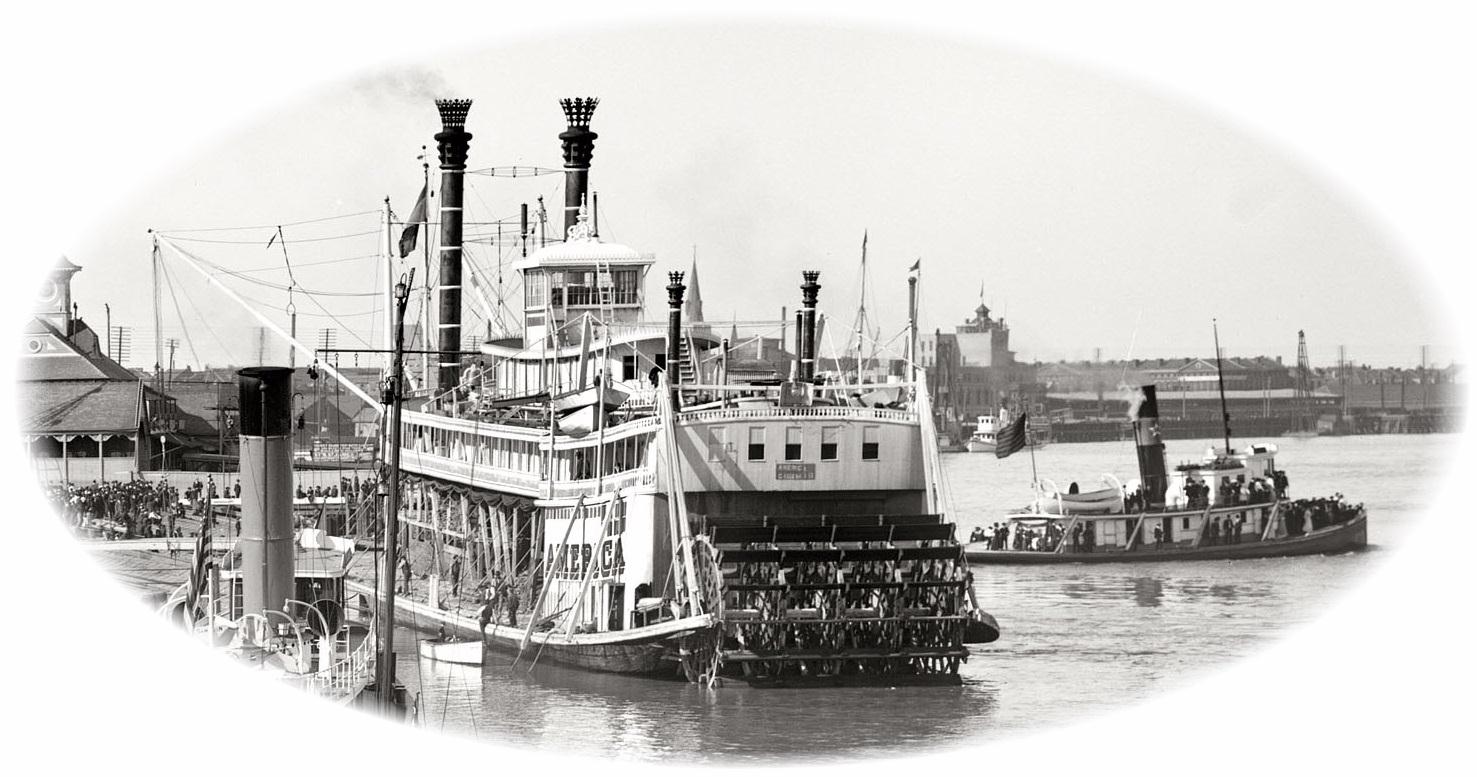
Detail inside an oval vignette from the upper right quadrant of a 1906 Detroit Publishing photograph taken at New Orleans with a nice stern angle of Captain Cooley's AMERICA.
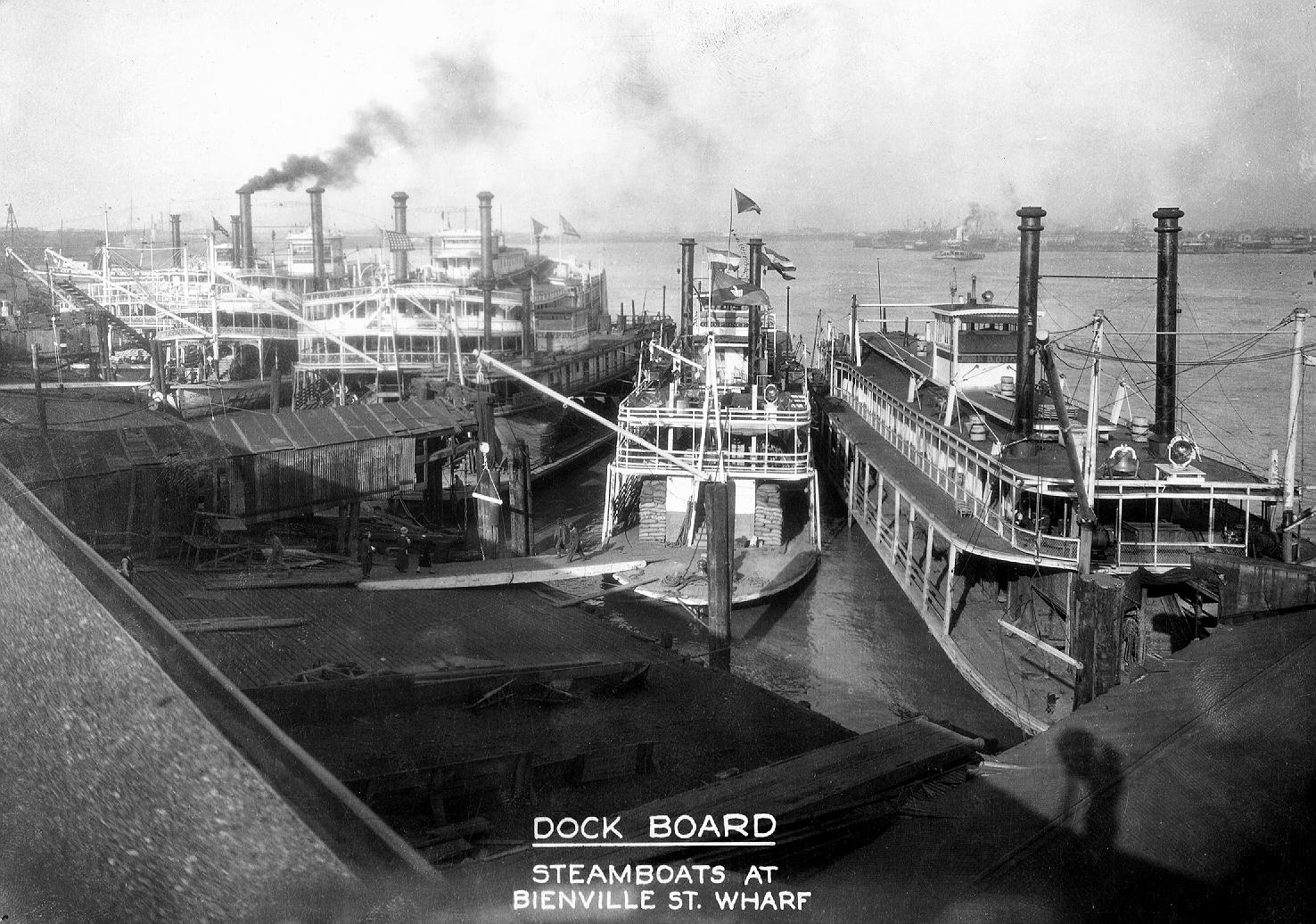
BIENVILLE STREET WHARF, NEW ORLEANS
Taken during Mardi Gras in February of 1924, '26, '27 or '28.
Captain Cooley's Steamer John D. Grace is sixth in line, foreground above.
Left to right:
1 CAPE GIRARDEAU built in 1923 and christened in Apr. 1924. She ran Mardi Gras trips from 1925 to 1930.
2 QUEEN CITY 1897 - 1933 Celebrated at great length by Fred Way in his Packet Directory.
3 CINCINNATI double cabin steamboat, hull build by Midland Barge Co., Pittsburgh and completed at Cincinnati in 1924.
4 CLIPPER burned in March, 1928 at the Bienville Street wharf.
5 GEO. PRINCE built 1922. Named for Captain George Prince, a steamboat man.
6 JOHN D. GRACE 1917 - 1930
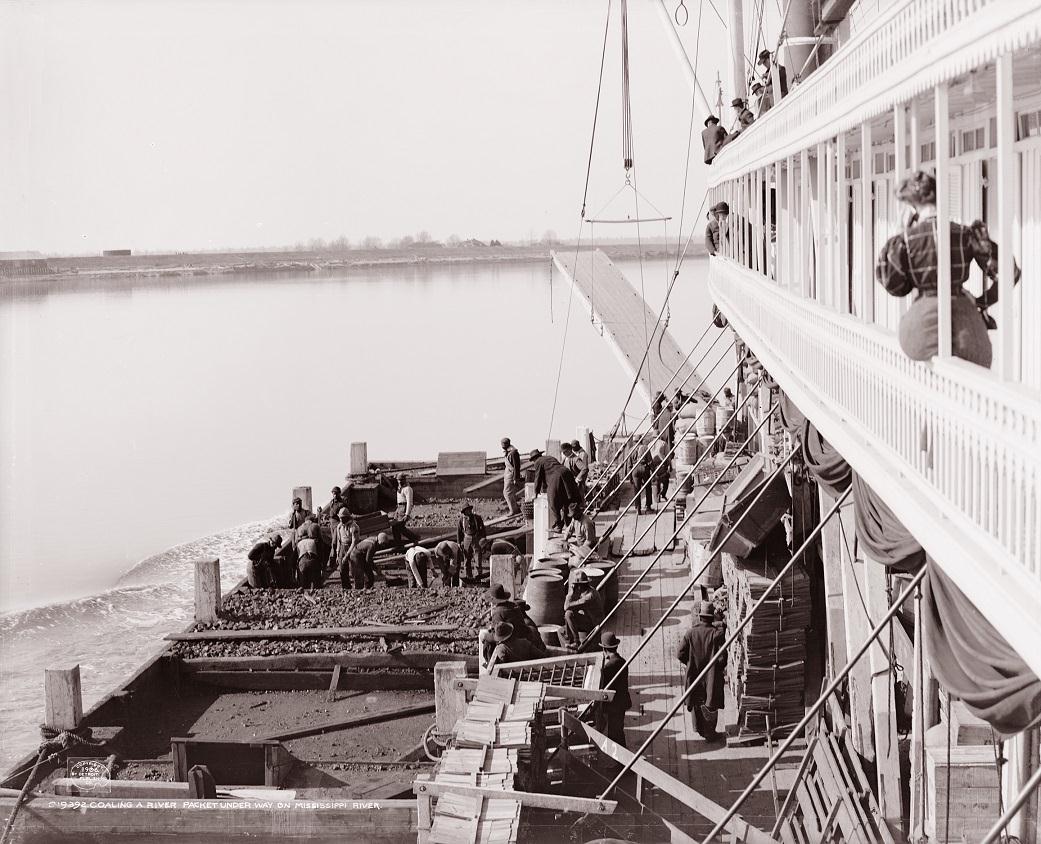
"Coaling a River Packet Under Way on the Mississippi River"
Detroit Publishing Co. 1906.
(Refueling a steamboat from a barge carrying coal).
From the Library of Congress digital collection.
Judging from what can be seen of the port side smokestack it is probable that the steamboat was Captain La Verrier Cooley's AMERICA (1898-1926).
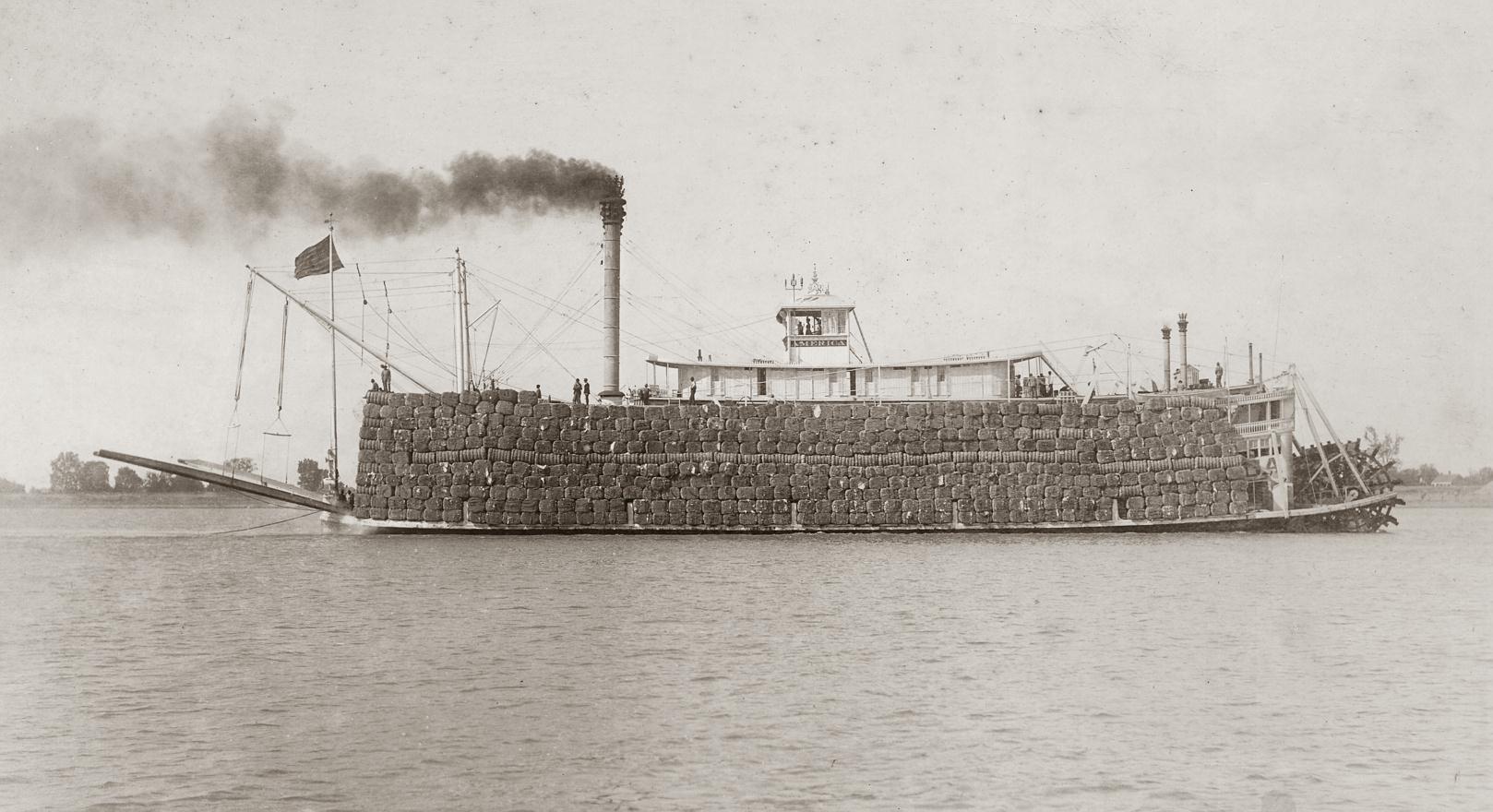
Attached scan of an original framed albumen print of Captain Cooley's AMERICA loaded with cotton that I purchased from Dave Dugas in his Le Petit Solider antique shop on Royal Street in October, '89.
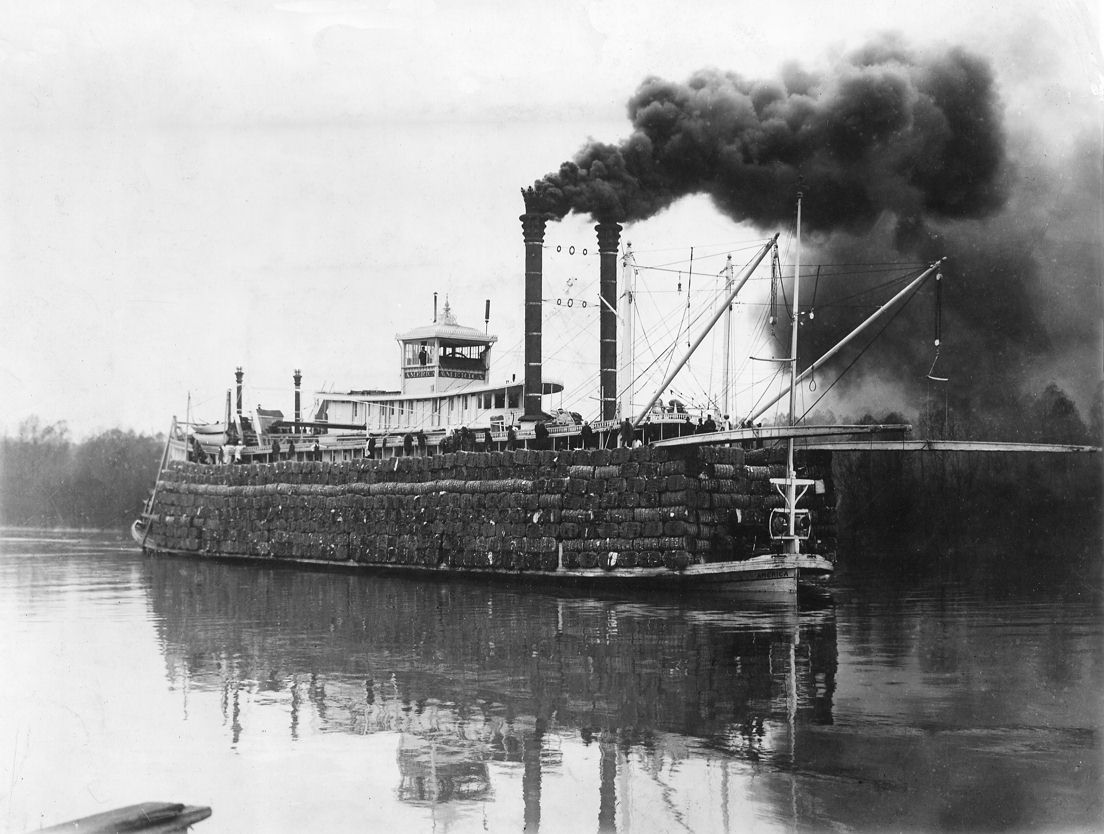
This shows a photograph that the artist based Ray's painting of Captain Cooley's AMERICA on. The present owner of the painting is Terrell Dempsey of Quincy, Illinois. Terrell was living in Hannibal, Missouri when he wrote Searching for Jim: Slavery in Sam Clemens's World to which Dave Thomson contributed research and illustrations. Dempsey's book is Searching for Jim: Slavery in Sam Clemens's World, available from Amazon.com.
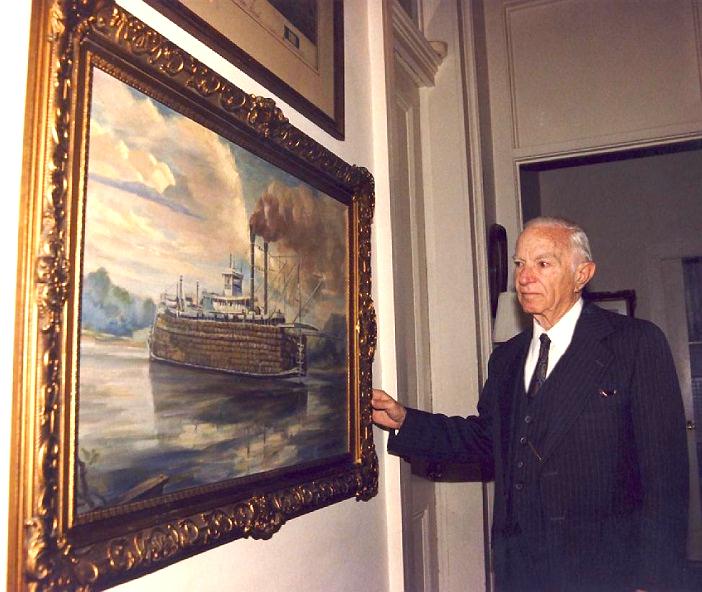
Caption from
THE REFLECTOR September 1990, page 35:
"The late Ray Samuel pictured in his home, 1225 Washington Ave., New Orleans, last October, by Dave Thomson. Our June 1990 issue, page 47, carried the obituary for Ray, who died Monday, April 16, 1990, age 75. The framed oil painting is of Capt. L.V. Cooley's cotton sternwheeler AMERICA, which appears on our back cover as the WINFIELD SCOTT."
Ray Samuel co-authored TALES OF THE MISSISSIPPI with Leonard V. Huber and Warren C. Ogden - Published in 1955 by Hastings House, New York
"I spent a couple of days with Ray Samuel in New Orleans during October of 1989 and took the attached photo of him in his home in the Garden District. Ray may have been the biggest collector of artifacts from Louisiana history with an emphasis on steamboats. I bought a few things from his history shop in the Garden District but couldn't afford some of the truly amazing things that he owned including a large mirror from a steamboat cabin with slots in it for advertising from steamboat men and merchants etc. to place their promotional cards and broadsides etc. The mirror was "full up" with original cards.
The painting of the cotton packet AMERICA ended up being bought a couple of years ago by Terrell Dempsey, a Hannibal attorney who wrote a book called SEARCHING FOR JIM. I provided a number of illustrations for the book.
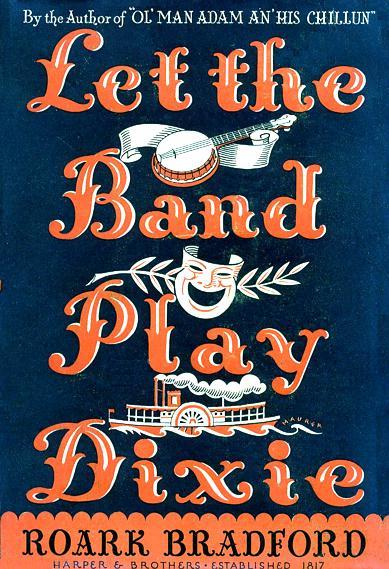
Author Roark Bradford was born in Tennessee in 1896 but made his permanent home in New Orleans where he died in 1948.
He is best known for his stories of African Americans in the Deep South. In his stories the negro characters speak in a heavy dialect.
Bradford's book "Old Man Adam and his Chillun" formed the basis for the popular stage play THE GREEN PASTURES adapted by Marc Connelly in 1930
Bradford derived the title of the book from the following incident that occurred on April 14th, 1896 in Washington D.C. after the news of Lee's surrender to Grant reached Washington D.C.
The following first person account is edited from an article published in the New York Times on August 11, 1907
"When we arrived outside the White House some regiments were marching past with bands playing and colors flying.
President Abraham Lincoln leaned far out of the window as he said:
'Now let the band play DIXIE, it belongs neither to the South or the North but to us all.'
The band played DIXIE. For the first time in four years that air was heard in the Nation's capital."
nytimes.com
Steamboats are key elements related in five of the stories in the the collection LET THE BAND PLAY DIXIE published in 1934:
Chapter 3 The Indian Summer of Bugaboo Jones
Chapter 5 The Razor Man
Chapter 7 Come Day, Go Day
Chapter 9 The Final Run of Hopper Joe Wiley
Chapter 10 Three for a Nickel.
Bradford used Captain LaVerrier Cooley as a character in my favorite of these steamboat tales entitled "Three for a Nickel."
Cooley was born in Savanna, Illinois Nov. 16, 1855 and died on Dec. 19, 1931.
The roof bell from Captain Cooley's favorite cotton packet, the AMERICA is part of the monument over his grave at Metairie Cemetery in New Orleans.
So far I have not been able to find a direct connection between Cooley and the packet JOHN D. GRACE (built 1917, dismantled 1930) but apparently both Captain Cooley and the GRACE were favorites of Bradford's and perhaps he chose to honor both of their memories by featuring them prominently in the story "Three for a Nickel." (see photo below of the John D. Grace)
Let the Band Play Dixie and Other Stories
by Roark Bradford
Harpers 1934
Chapter 10 "Three for a Nickel"
(opening passage - excerpt)
Captain Cooley, owner and master of the Mississippi River packet John D. Grace, was a scholar and a gentleman. His tastes were cultivated -- he would never become a faddist. However, being absolute master in fact as well as in name of the finest steamboat on the Southern rivers, and, incidentally, a good liver, he not only got just about what he wanted but always got the best of what he wanted.
Once, years ago, his physician in New Orleans had recommended that he drink a glass of sweet milk with each meal -- a simple enough prescription for a city dweller but one which might be difficult to fill three times a day in the isolated stretches of river traversed by his steamboat. "Any particular kind of milk?" the captain wanted to know.
"Not especially," the doctor told him. "They say a Jersey cow's milk is richest in butter fat, but after it goes through the distributing dairies it all comes out about the same."
Captain Cooley thereupon consulted a deep-sea skipper friend who sailed between New Orleans and European ports, and two months later a cow, straight from the Island of Jersey, was installed on the after main deck of the John D. Grace. A roustabout was assigned to the full-time job of caring for the cow: feeding her when the boat was running and grazing her on the levee at landings; and, most important of all, seeing to it that the captain had a glass of fresh sweet milk with each meal.
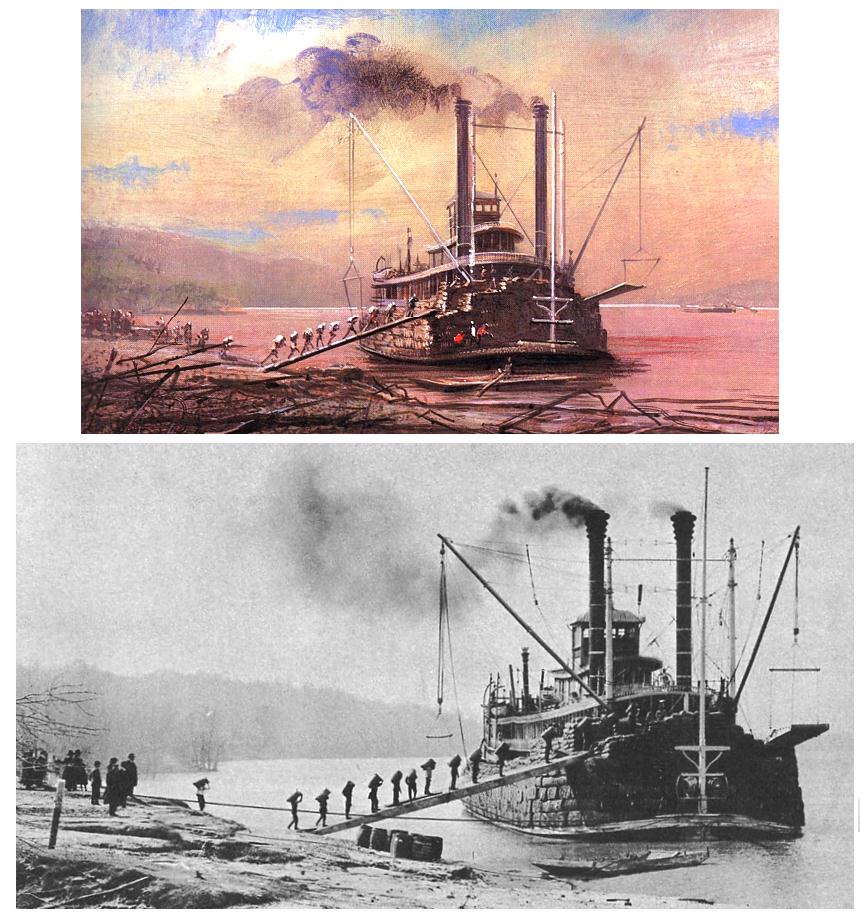
Photo of Captain Cooley's cotton packet AMERICA was the inspiration for one of artist John Rose's illustrations in a 1982 edition of Mark Twain's ADVENTURES OF HUCKLEBERRY FINN. Looks like the crew of roustabouts were carrying sacks of grain up the "stage" to the deck of the AMERICA. The Mississippi looks like pink lemonade . . . such a rosy shade. Handling of sky and smoke is nice.
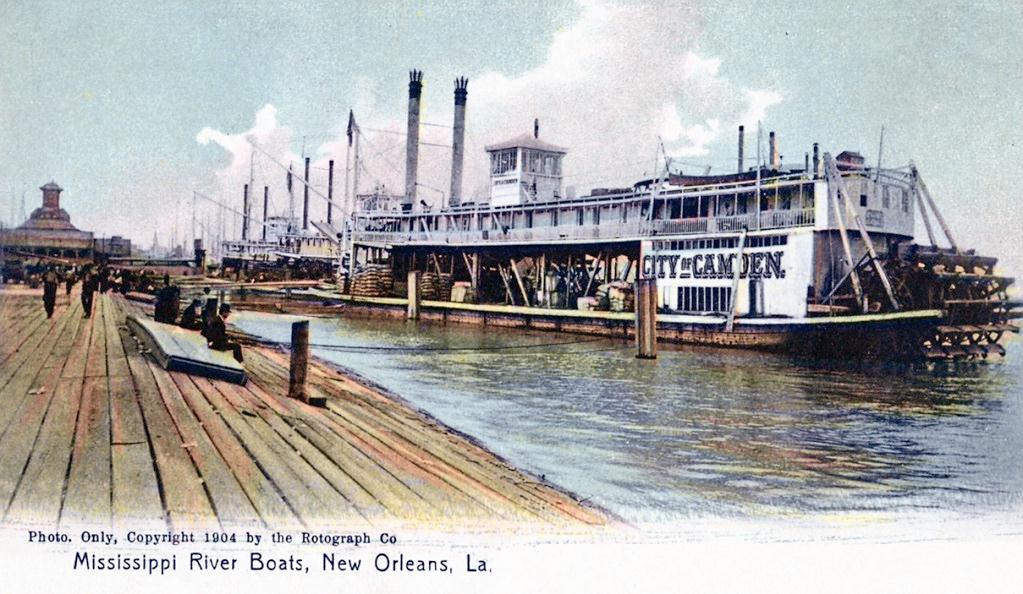
CITY OF CAMDEN
Sternwheel Packet
Way's Packet Directory Number 1059
Captain Jesse McMahan (first owner);
Captain L. V. Cooley (master); M. E. Fahy (clerk)
Ouachita River; Red River; Alabama River; Mississippi River
Built in 1893 at Jeffersonville, Indiana by Howard Ship Yards
Original price $19,000. Home port or owner's residence circa 1893, New Orleans.
Ran New Orleans-Camden on the Ouachita River. Also made trips up the Red River
Got in a hurricane at Mobile (1906) and was blown out on mud flats and dismantled in 1910.
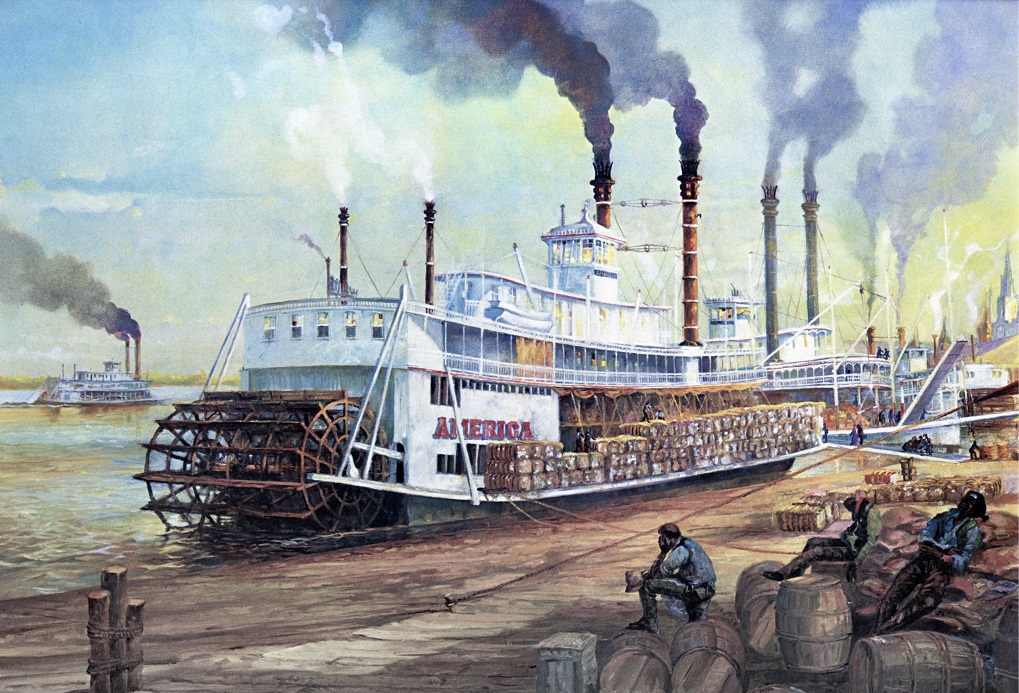
Robert Rucker's painting of Captain Cooley's AMERICA.
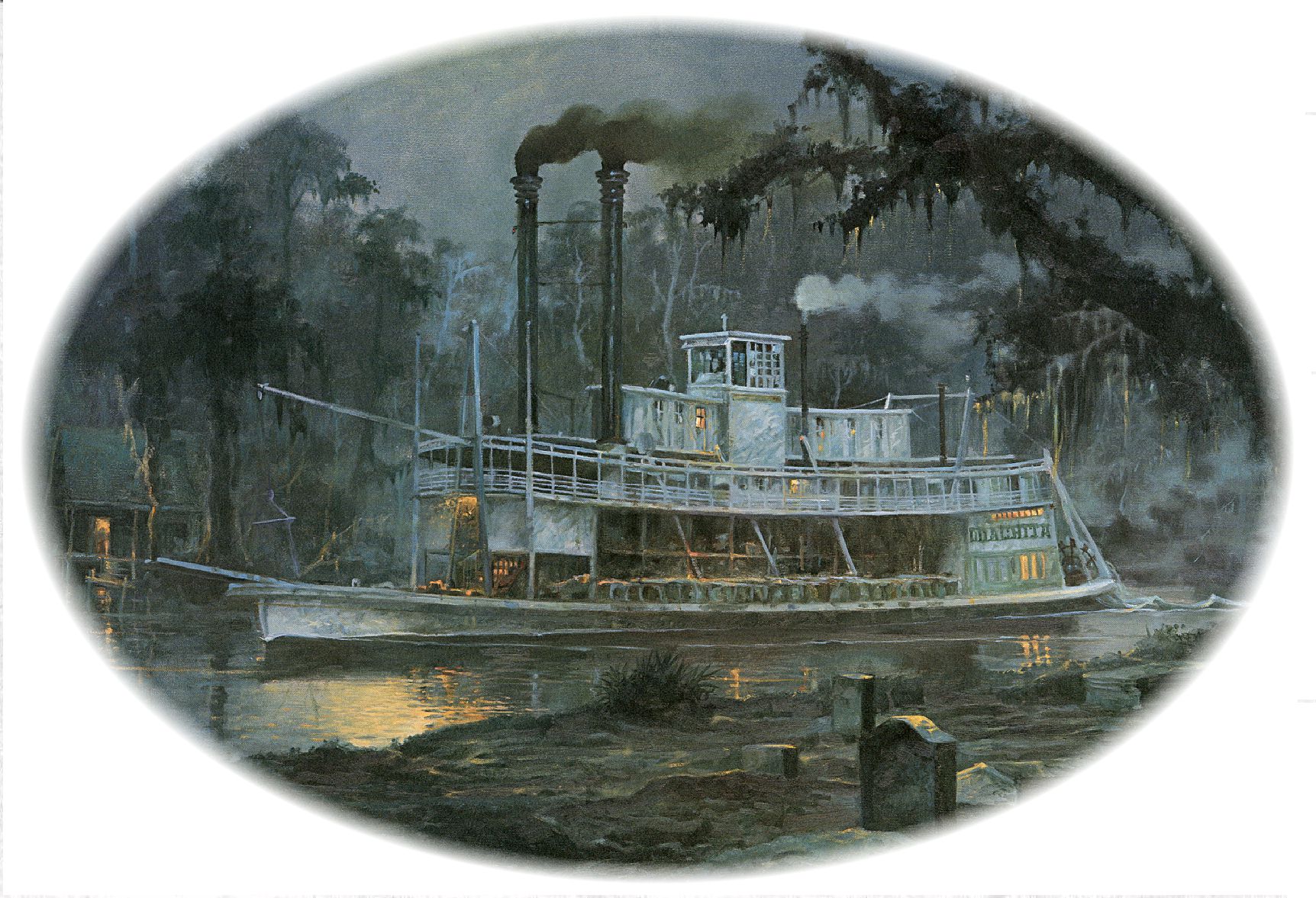
I just received a large print of Robert Rucker's "Ghostly Steamboat" . . . attached oval vignette version showcasing the boat and a photo that Jim Hale found on the Murphy site of the "Little Ouachita" after she was abandoned to the elements above Mobile around 1909 with her stacks leaning sadly from neglect.
Photo Courtesy of Murphy Library at the University of Wisconsin - La Crosse Steamboat Collection Photographs.
From Jim Hale's message:
THE BOAT IS THE "LITTLE OUACHITA" BUILT AT HOWARD'S IN 1899 TO RUN ON THE UPPER OUACHITA IN LOUISIANA TO BRING COTTON DOWN TO MONROE TOO BE THEN SHIPPED ON THE "AMERICA" TO NEW ORLEANS. CAPTAIN COOLEY HAD BUILT THE "AMERICA" IN 1898 AND THEN HAD THE "LITTLE OUACHITA" BUILT THE NEXT YEAR. HE SOLD THE "LITTLE OUACHITA" IN 1906 TO THE ALABAMA RIVER PACKET CO.
THE PILOT HOUSE WAS RAISED AND THE NARROW TEXAS BUILT IN FRONT OF AND BEHIND IT AFTER IT GOT TO MOBILE. THE "LITTLE OUACHITA" WAS LAID UP IN 1909 OR SO ABOVE MOBILE WHERE THE PICTURE THE MURPHY LIBRARY WAS TAKEN. THE BOAT LOOKED A LOT BETTER BEFORE THE TEXAS WAS ADDED.
THIS PAINTING OF HER BY RUCKER, HAS TO BE THE MOST GHOSTLY STEAMBOAT PAINTING EVER. MAYBE SHE STILL HAUNTS THE BAYOUS ABOVE MOBILE EVEN TO THIS DAY.
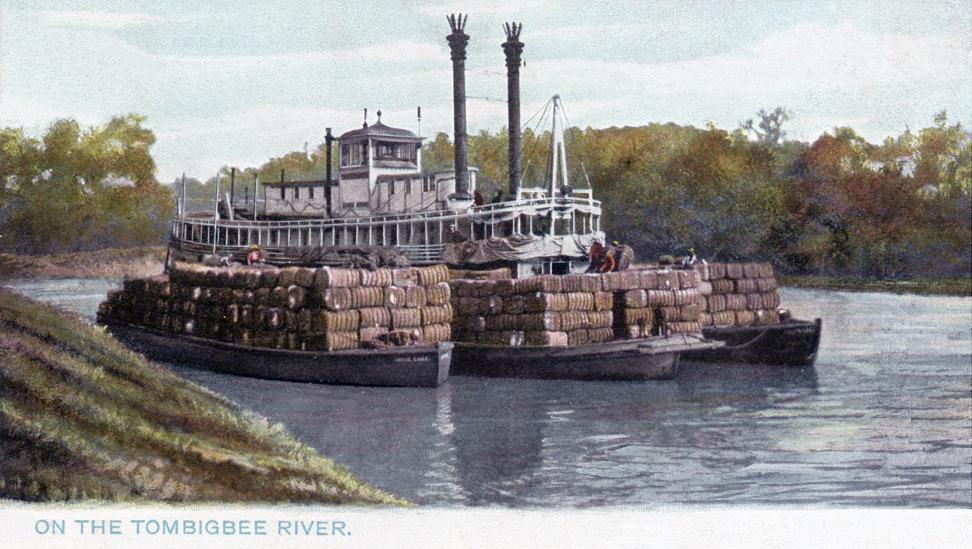
This postcard was dated 25 December 1906 on the front, not post marked so it must've been enclosed in an envelope when it was sent.
Information on verso:
Raphael Tuck & Sons
ART PUBLISHERS TO THEIR MAJESTIES THE KING AND QUEEN.
postcard Series No. 23709
"In the Land of Cotton."
The steamboat LITTLE OUACHITA pushing barges (above) was the same boat that Robert Rucker painted as a "haunted" sternwheeler and we paired his painting up with a photo from the La Crosse, above.
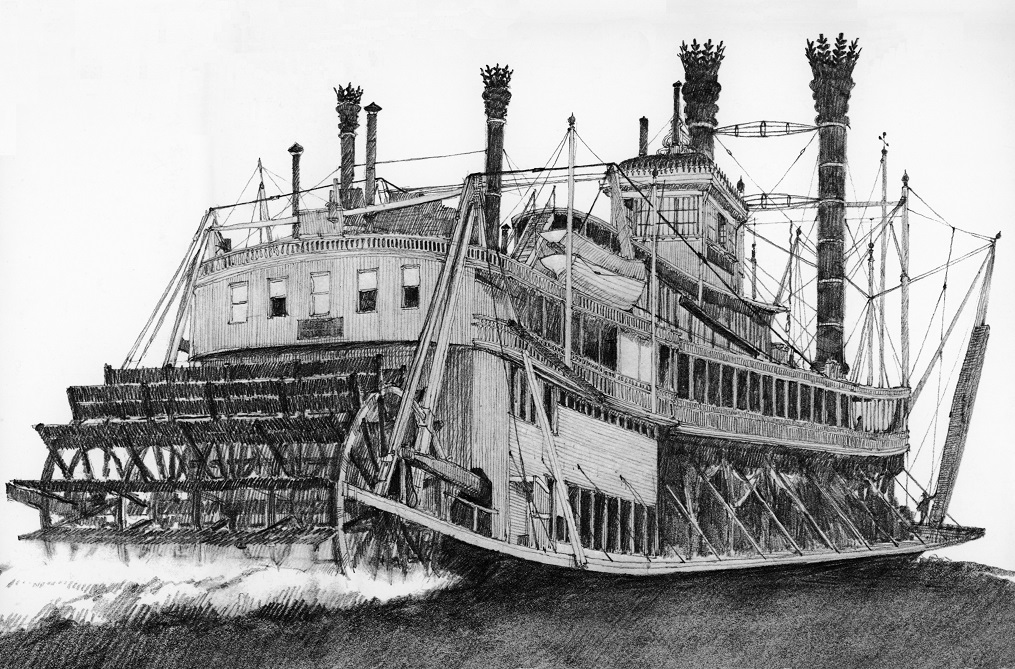
Dust jacket drawing from The Illustrated History Of Paddle Steamers
By George W. Hilton, Russel A. Plummer & Joseph Jobé Drawings by Carlo Demand
George W. Hamilton assembled the illustrations for the chapter on American steamboats.
EDITA LAUSSANE
Published by The Two Continents Publishing Group, 1976
Printed in Switzerland
Jim Hale on the identity of the boat depicted on the cover:
DAVE
THOUGH THE PICTURE OF THE BOAT HAS NO NAME ON IT I KNEW THAT IT WAS CAPTAIN COOLEY'S "AMERICA" WHICH I HAVE BEEN IN LOVE WITH SINCE THE FIRST TIME I SAW A PICTURE OF IT IN A BOOK WHEN I WAS IN THE ARMY.
COOLEY WAS ONE OF THE LAST OF THE OLD TIME STEAMBOAT CAPTAINS ON THE LOWER MISSISSIPPI. HE LOVED THE AMERICA BEST OF ALL THE BOATS HE OWNED.
THANKS FOR THE DRAWING.
JIM
Fighting Coward - Silent Film
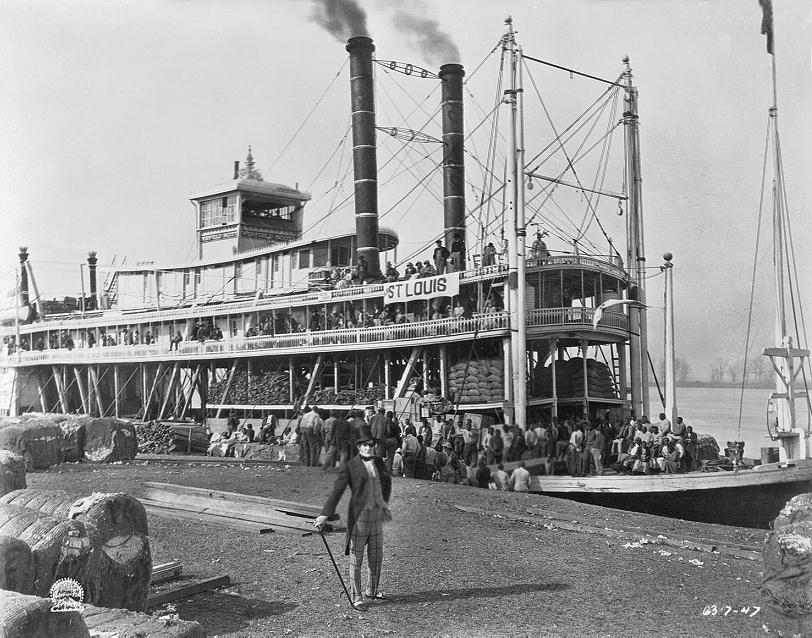
Captain Cooley's AMERICA as the "Winfield Scott" in the 1924 silent film THE FIGHTING COWARD, the first of 3 adaptations of Booth Tarkington's play MAGNOLIA. The other two versions were the talkies RIVER OF ROMANCE, 1929 with Wallace Beery and MISSISSIPPI, 1935 with Bing Crosby and W.C. Fields.
The gent with the eye patch in the foreground is actor Ernest Torrence in the role of General Orlando Jackson. In 1928 Torrence portrayed Captain William 'Steamboat Bill' Canfield, father of Buster Keaton's character William Canfield Jr. in STEAMBOAT BILL JR.
I found this movie still back in the 90s and loaned it to Ralph DuPae to copy and he had a negative made of it and added it to the Murphy Library collection.
THE AMERICA IN A SILENT FILM
Fighting Coward
Madera, California is located in the San Joaquin Valley
Madera Tribune NEWSPAPER promotion
14 August 1924
Transcript of Advertisement:
NATIONAL Theatre
Madera's Cool Spot
Come and see "The Fighting Coward" change his yellow streak to blood-red!
Howl while he gets a reputation as a dangerous-as-dynamite desperado!
For that's where the big fun starts In this laugh-a-second Cruze-directed comedy hit. with ERNEST TORRENCE - MARY ASTOR - NOAH BEERY
STORY:
FIGHTING COWARD
LEADING PICTURE
James Craze and his entire producing company of actors, actresses, electricians, carpenters, cameramen, extras, etc., traveled overland a distance of 4300 miles from Hollywood to Natchez, Miss., for scenes tor the new Paramount picture, "The Fighting Coward." Within a short distance of the historic southern city, the man who made "The Covered Wagon, "Hollywood." "Ruggles of Red Cap," "To the Ladies" and other successes, found the exact locations called for in the Booth Tarkington story, one of Southern life before the Civil War. Real old Southern mansions, steamboats, levees and plantations serve as the background for the dramatic action. Natchez turned out to a man to assist the director in making his new production a faithful motion picture record of life in the south about 1850.
James Cruze has established a reputation for the notable casts of his productions, and the list of players, who appear in "The Fighting Coward," is of the same brilliant character as the rosters of "The Covered Wagon" and the rest. Ernest Torrence, Mary Astor, Noah Beery, Phyllis Haver and Cullen Landis are featured in the picture, which opens a two days run at the National Theatre tonight. Others include Carmen Phillips, Bruce Covington, Helen Dunbar and Frank Jonasson. Landis has the role of Tom Rumford, southern born but northern bred, who returns to his home in the South and becomes engaged to his cousin. He encounters the terrible dueling code which prevails, and of which he is ignorant. He is challenged to a duel by a rival for the girl's hand, and refuses because he firmly believes that this is just a polite form of murder. He is driven from his home and deserted even by his sweetheart. The story of his final triumph and the finding of a now love forms one of the strongest, not to say strangest, climaxes ever filmed. An excruciatingly funny comedy "Smile Please," featuring the funniest of all screen comedians Harry Langdon, together with the International News reel of world events, completes an unusually attractive program.
A Paramount Picture
The Fighting Coward
A James Cruze Production
California Digital Newspaper Collection
cdnc.ucr.edu
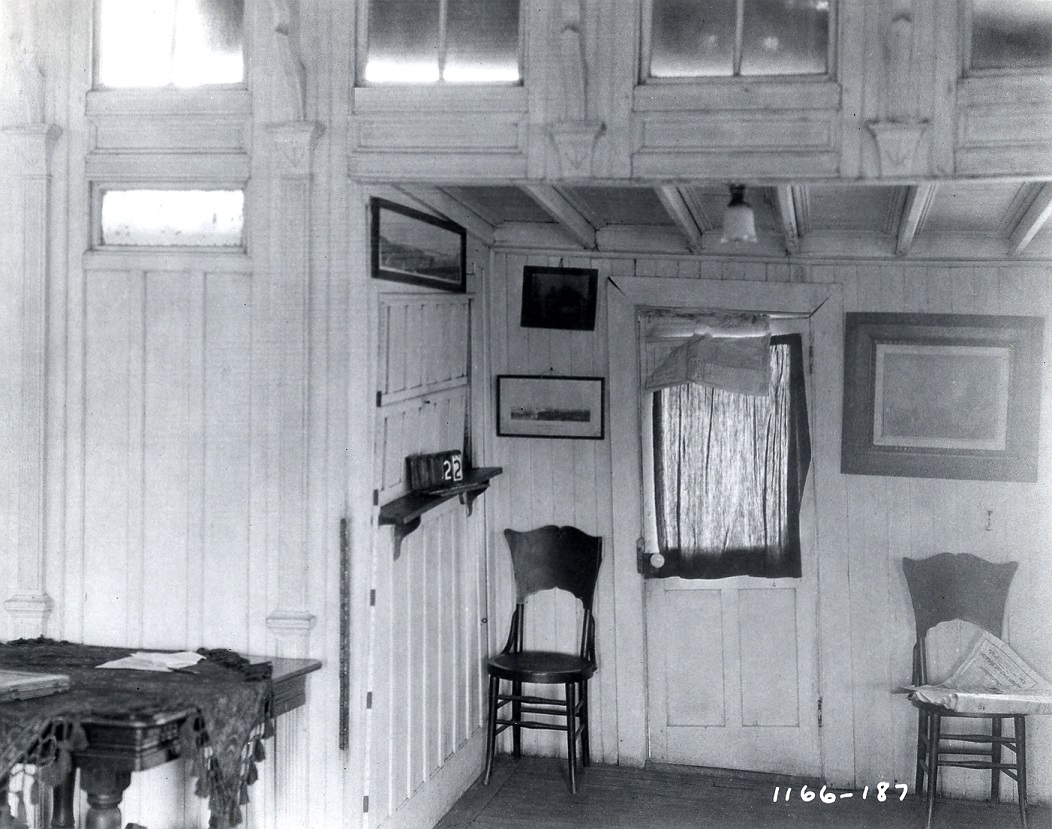
Photo taken by still camera operator during the filming of THE FIGHTING COWARD in the cabin of Captain Cooley's AMERICA in March, 1924. A reference slate with the number 22 is on the narrow counter of the clerk/purser's office next to a door leading to the deck outside. Hinged vertical shutters above the counter can be opened for business when the clerk and/or the purser are on duty to serve the passengers.
In THE FIGHTING COWARD the AMERICA's name was changed to "WINFIELD SCOTT" (see photo of actor Ernest Torrence above).
Madera, California is located in the San Joaquin Valley
Madera Tribune NEWSPAPER promotion
14 August 1924
Transcript of Advertisement:
NATIONAL Theatre
Madera's Cool Spot
Come and see "The Fighting Coward" change his yellow streak to blood-red!
Howl while he gets a reputation as a dangerous-as-dynamite desperado!
For that's where the big fun starts In this laugh-a-second Cruze-directed comedy hit. with ERNEST TORRENCE - MARY ASTOR - NOAH BEERY
STORY:
FIGHTING COWARD
LEADING PICTURE
James Craze and his entire producing company of actors, actresses, electricians, carpenters, cameramen, extras, etc., traveled overland a distance of 4300 miles from Hollywood to Natchez, Miss., for scenes tor the new Paramount picture, "The Fighting Coward." Within a short distance of the historic southern city, the man who made "The Covered Wagon, "Hollywood." "Ruggles of Red Cap," "To the Ladies" and other successes, found the exact locations called for in the Booth Tarkington story, one of Southern life before the Civil War. Real old Southern mansions, steamboats, levees and plantations serve as the background for the dramatic action. Natchez turned out to a man to assist the director in making his new production a faithful motion picture record of life in the south about 1850.
James Cruze has established a reputation for the notable casts of his productions, and the list of players, who appear in "The Fighting Coward," is of the same brilliant character as the rosters of "The Covered Wagon" and the rest. Ernest Torrence, Mary Astor, Noah Beery, Phyllis Haver and Cullen Landis are featured in the picture, which opens a two days run at the National Theatre tonight. Others include Carmen Phillips, Bruce Covington, Helen Dunbar and Frank Jonasson. Landis has the role of Tom Rumford, southern born but northern bred, who returns to his home in the South and becomes engaged to his cousin. He encounters the terrible dueling code which prevails, and of which he is ignorant. He is challenged to a duel by a rival for the girl's hand, and refuses because he firmly believes that this is just a polite form of murder. He is driven from his home and deserted even by his sweetheart. The story of his final triumph and the finding of a now love forms one of the strongest, not to say strangest, climaxes ever filmed. An excruciatingly funny comedy "Smile Please," featuring the funniest of all screen comedians Harry Langdon, together with the International News reel of world events, completes an unusually attractive program.
A Paramount Picture
The Fighting Coward
A James Cruze Production
California Digital Newspaper Collection
cdnc.ucr.edu
Remembrances of Captain L.V. Cooley
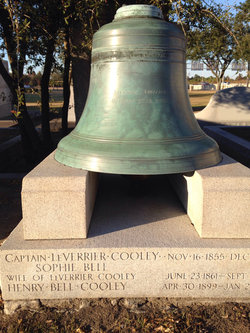
Cooley's memorial incorporates the bell from the America. findagrave.com
Captain Le Verrier "L.V." Cooley 1855-1931
Born 16 November 1855 in Savanna, Carroll County, Illinois
Died 19 December 1931 at age 76
Buried
Metairie Cemetery
New Orleans, Orleans Parish, Louisiana
Obituary
The Monroe News-Star
Monday, December 7, 1931
Page 1
Jes' Ramblin'
ABOUT THE TOWN.
By H. H. B.
Capt. L. V. Cooley, proud master of the steamer Ouachita, has a memory that runs back to far earlier days on both the Ouachita and the Mississippi Rivers. He remembers all the famous steamboats of the post-Civil War era, the Natchez, the Robert E. Lee and others. He knew Mark Twain and the comment he made several years ago has become almost classic:
"Yeah, I knew Mark Twain," said Captain Cooley. "Not when he was on the river, but that time when he came back down here. In the eighties I think it was. River men don't think so much of Mark; the way he wrote, you know, you wouldn't think there was anybody but the pilot on a steamboat.
"Was he a good pilot?"
"Oh, not so good, not so good. There was never a good pilot could do anything but pilot a steamboat. Mark Twain could write, couldn't he? Well?
Obituary
The Monroe Morning World.
Sunday, December 20, 1931
Page 1; Column 1
CAPTAIN COOLEY DIES AT ORLEANS; SICK SHORT TIME.
Master of Steamer Ouachita Was Stricken While Ship Sped Down River.
HAD LONG CAREER UPON STREAMS OF SOUTHLAND.
Skipper at 19, He Had Devoted His Entire Life to Work on Waterways.
Obituary
NEW ORLEANS, Dec. 19 (Special) -
Captain L. V. Cooley is dead. The doughty and picturesque master of the steamboat Ouachita, who continued to navigate his craft even when stricken with paralysis and had to be driven to a hospital - almost literally - has swung into the harbor of the resurrection after navigating the tortuous stream of life for 76 years. And so passes the last connection between the old river days and the new, Captain Cooley was the last of the lower river captains.
He died in Baptist Hospital Saturday afternoon, surrounded by his family - his wife, formerly Miss Sophie Bell of New Orleans, and their children, Miss Sophie Cooley, teacher in the Sophie Wright High School of New Orleans; Miss Esther Cooley, teacher at Natchitoches Normal School; Laverriere V. Cooley, Jr., attorney at Slidell; and Henry B. Cooley, civil engineer with the Louisiana Highway Commission.
Captain Cooley will be buried tomorrow afternoon at 3 p.m. in Metairie Cemetery here.
He was stricken at the helm of the Ouachita at Columbia, La., about two weeks ago. He was bringing a cargo of 4,000 bales of cotton to New Orleans. Though one side of him was dead, he refused to delegate the command to his mate Sam Cotton, who holds a master's license. Captain Cooley felt his responsibility, he loved his boat, and the river was the flowing current of his life. From his stateroom, he navigated the packet and brought her safely to New Orleans. His family, summoned to his bedside, served as his eyes; stationed at different windows of the boat, they sang out as the Ouachita passed the landmarks and told Captain exactly where they were all the time. As a matter of fact, he could almost have brought the boat to New Orleans by the "feel" so well did he know the river.
When the Ouachita reached New Orleans, the family had a battle royal to make him consent to go to the hospital. He wasn't sick, he said; he'd soon be up and doing; his duty was on board. It was a terrific wrench for him to leave the boat, for the boat was more than a command it was a home - The Ouachita and The America before that, and the others before that. He took his bride aboard and they made his boat their home ever since their marriage day.
He was a happy and downright personality, "river captain" etched into every line of his face; and why not? - for Captain Cooley has held a master's license ever since he was 19 years of age. His face was toughened - and freshened - by the winds and the sunlight of the rivers he loved so well. His eyes were sharp from penetration into the hidden things of current and weather, his voice was bluff and hearty. A typical riverman, product of the great open spaces, alert to danger, instant in meeting emergencies. He knew Mark Twain, whom he met when Mark returned to the river, a famous writer, seeking material to expand a short book of sketches "Old Times On the Mississippi" into the bulky volume "Life On the Mississippi."
He was born in [Savanna], Ill., on November 16, 1855. He heard the call of the river when he was 15. He drifted south on a flatboat, and the lure of the Mississippi held him ever since. He was born for the river, and it took him only four years to rise from cabin boy, clerk, roustabout or what have you, to be captain; a full-fledged master at the age of 19, with the papers to show for it, and his own deck to tread - heavy responsibilities for a mature man, much less a bearded youngster. He soon became famous for the sureness with which he kept his schedules, and the soundness of his judgment in navigating a stream whose shifting currents and hidden menaces made that stretch of water feared by all owners, pilots and captains. Captain Cooley never lost a boat of which he was in personal command. Some of his boats found their graveyard in the river, but he was always ashore at the time, and the command was delegated to others. This is an amazing record, when you remember that the Mississippi, in the latter part of the nineteenth century, was not the carefully charted, beaconed and "policed" stream it is now.
He made a few trips in northern waters, but not many. Practically his entire life was spent on the lower Mississippi, on the Ouachita, on the Red, on the Black, on the Tensas and on the Boeuf. He knew them all as well as the average man knows the hallway in his home.
Up and down this river system, he was as well known as the sunrise - and as well liked.
He came south in 1870. For 61 years, then, he has roamed the rivers of the South. He passed through the carpetbag rule, and the terrible years when railroad competition tore at the little business which the economic crash had left to the rivers. He saw the great streams, once so heavily populated, become deserted villages, as it were; the saw the arteries of commerce that had made the South, become mere obstacles to communication and transportation, breeders of chills and fever, a menace to life and property. And he saw the sun of a new economic era rise and dispel this blighting miasma, and the rich trade begin once more to billow down the father of waters and its children, the tributaries. He helped to bring about this revival, a towering beacon of confidence who kept, the eyes of confidence and hope riveted upon the possibilities of the river and helped to inspire the demand that brought the government to the rescue of one of the greatest of the country's natural resources, with the Federal Barge Line and protected rate structure that encouraged private enterprise to seek again the flowing road.
Throughout his career, Captain Cooley was always an independent operator. He affiliated himself several times with river transportation systems, but always retained his freedom of action. He survived where others went under, because he knew his river and his boat, and he knew the shifting currents of business and how to avoid the sandbars.
He carried an enormous cargo of commerce up and down the Mississippi and its tributaries during the voyage of his life. Ever since the revival of the river traffic, he has operated steadily, throughout the year. He bought the Ouachita in 1925.
The Ouachita is now in Monroe, on the down trip. Sam Cotton is in charge-the master now, with the full rank of captain. The Ouachita will continue to operate, as usual. She won't appear the same, as she swings into the bank, without the commanding figure of Captain Cooley on her hurricane deck, but she sill be the embodiment of the spirit of Captain Cooley for all that, a floating monument to the man who helped to bring back the olden, golden days.
Captain Cooley has been a "river man" since he was 15 when he left his home in Savanna, Ill., at that age coming south on a flatboat.
By the time he had reached the "ripe age" of 19 he was a licensed river captain, and at 31 he married Miss Sophie Bell of New Orleans, who since her marriage has made her home with the captain aboard various steamboats.
Four children, all successful and all proud of their father, were at his bedside when the end came. These were Miss Sophie Cooley, a teacher in the Sophie Wright High School of New Orleans, Miss Esther Cooley, a teacher at Natchitoches State Normal School; LaVerrier V. Cooley, Jr., attorney at Slidell, La., and Henry B. Cooley, civil engineer with the Louisiana State Highway Department.
One of the great admirers and at many times in his life, sources of greatest assistance, was his brother, Capt. G. B. Cooley, of Monroe. This only surviving brother has been at the bedside of the stricken captain as much as it was possible since he first became ill. He was summoned Friday when word came to Monroe that there was little hope of recovery and that the end might be expected at any time. Upon receipt of this word Mr. Cooley left last night for New Orleans and was present when the end came.
The funeral of the veteran steamboat man will be held at 3 o'clock this afternoon with interment in Metairie Cemetery, New Orleans.
Obituary
Monroe News-Star
Monday, December 21, 1931
Page 10
FUNERAL IS HELD FOR CAPT. COOLEY, VETERAN SKIPPER.
Last rites were held at New Orleans yesterday for Capt. L. V. Cooley, 76-year-old river pilot who was widely known as "the grand old man of the river." Burial was made at Metairie Cemetery.
Capt. Cooley is survived by his widow and four children, and a brother, Capt. G. B. Cooley of Monroe.
Since he was 14 years old, Capt. L. V. Cooley had worked on steamboats, operating on the Mississippi River and its tributaries. In later years, a number of magazine and newspaper stories reviewed his life and presented pictures of himself and his steamer, "The Ouachita." He was the last of river pilots of the old school, a link between the past and present.
Capt. Cooley's post as master of "The Ouachita," has been taken over by *Sam Cotton, who was next in command on the steamer.
*A Dec. 25, 1931 article in the Monroe News-Star announced Sam Cotton would be master of the ship with Henry B. Cooley taking charge as manager of The Ouachita.
BIRTH
16 Nov 1855
Savanna, Carroll County, Illinois, USA
DEATH
19 Dec 1931 (aged 76)
New Orleans, Orleans Parish, Louisiana, USA
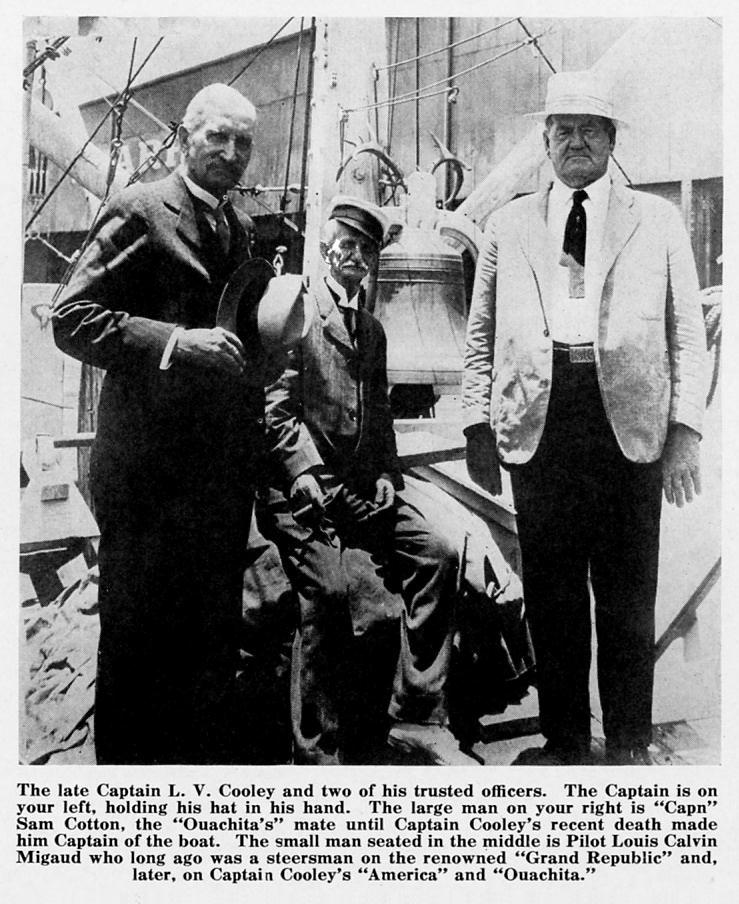
Capt. Cooley Had His Own Ideas About the Steamboat Business
By GARNETT LAIDLAW ESKEW
Author of "The Pageant of the Packets"
NATIONAL WATERWAYS - The American River and Harbor Authority
FEBRUARY 1932
pages 19, 20 & 21
"If the Federal Barge Line would add another deck to their express barges, and furnish and equip them for carrying passengers, they would find it greatly to their advantage."
The time was late Spring, 1931; the place, on board the sturdy little sternwheeler "Ouachita;" the speaker, Captain LeVerrier Cooley, dean of American steamboatmen who less than a month ago (as this page is written) died in New Orleans. He was standing, as he spoke, beside the OUACHITA's big bell on the hurricane roof. His cap was pushed to one side. His mustaches bristled picturesquely. His shrewd blue eyes seemed to take in everything within sight in the whole New Orleans harbor, up which the OUACHITA was then plodding her way towards the quiet fastness of Arkansas. The captain included, in this remark, Mate Sam Cotton, Pilot Louis Migaud and myself, who had gathered on deck to watch the river slip past.
Presently he resumed:
"Did you ever stop to think how much like the average old time steamboat those self propelled barges are? Add another deck, build in your staterooms, and right there, without going to hardly any expense, you've got a most efficient freight-and-passenger boat--lower deck for freight, boiler deck for passengers. Serve meals and add a few frills such as a negro orchestra for dancing purposes, and you'll always have a good passenger list. I know from experience with the OUACHITA.
Of course, in these times we can't hope to make a lot of money from passenger traffic, because nobody will travel by steamboat except for novelty and pleasure: the railroads have seen to that. But the number of people who are interested in the river and anxious to travel by steamboat for the sheer pleasure of it, is increasing all the time. People come out and make the two weeks round trip up into Arkansas with us, and they go and tell their friends about Captain Cooley and his old-time steamboat and the good meals they got while traveling with him. And right away their friends want to go and do likewise. The rivers and steamboating hold a great fascination for practically everybody. And that fascination should be capitalized on by the steamboatmen."
Captain Cooley laughed.
"They have been telling me for the past quarter of a century or more that steamboating with a packet in these days can never be made a paying business. Well, I have not been losing any money. I have always carried a good load of freight, and a good passenger list besides. My passenger list always feeds my crew and themselves; it's just that much gravy. It helps to reduce overhead expenses; and I never miss an opportunity to do that where it's possible. Besides that, carrying passengers on the river is fine advertisement and it helps to bring back the rivers as highways of commerce and travel."
For Captain Cooley believed with other steamboatmen that a new era of river transportation is imminent. When he came to New Orleans in 1869 to begin his steamboat career he was a youngster in his teens. He found the wharves of the Crescent City lined with the fine steamboats of the post-war period. He found a thriving freight and passenger commerce plying between New Orleans and St. Louis, Cincinnati, and the ports of the lower Mississippi.
Something like forty separate and distinct lines of boats were in operation, offering the ultimate (for those days) in luxurious accommodations and speed. The ironic aspect of this steamboating of the late sixties, the seventies and the eighties, is that a large part of their business, along about that time, was hauling supplies for the new railroads being built to parallel the river, which in time killed steamboating. But there was plenty of other freight besides railroad builders' supplies to be carried. Cooley got his pilot's license in 1872. Not until 1875 did be become a full-fledged master. Soon he was operating his own boat in the "five rivers" trade.
For the benefit of those unfamiliar with the layout of the river and bayou country of Louisiana it might be explained that the "five rivers trade" is that district between New Orleans in the South and Camden, Arkansas, in the North which requires using the following five streams:
The Mississippi for 200 miles to the mouth of Red River; Red River for 40 miles to the mouth of Black River, then by utilizing short stretches of Old River and White River, to the placid waters of Ouachita River which extends its navigable reaches 350 miles up to Camden, Arkansas.
It is a rich cotton country through which the five rivers flow—a country penetrated even today by few railroads, a country full of rich farm and plantation lands which roll back from water courses which the denizens look to as their principal highways of transportation. It was in this country that Captain Cooley began taking his boats (he operated seventeen steamboats in his time.) And before long he had built up a following of patrons who would not have thought of giving their cotton or any other of their freight to another steamboatman.
They soon recognized in Captain Cooley a man of unswerving integrity, a steamboatman who, if he said his boat would leave at five o'clock, took her out at sixty minutes past four. Those who knew him well knew him to be a shrewd, efficient business man who, as he himself often expressed it, landed anywhere along the rivers where there was any business to be had. There was plenty of business to be had along the five rivers and the Cooley boats got a just and sizeable share. But the Captain, always on the lookout for chances to build up new business, was not satisfied with taking merely what fell into his lap.
Through all that section of Louisiana, to east and west of the five rivers, run innumerable filaments of stealthy bayous, almost currentless rivers, each of which reaches up into its own separate little farming territory. Captain Cooley, while he was operating his big AMERICA the lovely larger predecessor of his OUACHITA, decided to get the business from up these tributaries. He made an arrangement with smaller boats to bring out the freight—and passengers, if any—from each of these districts. If there was no steamboat line running up a particular river or bayou, Captain Cooley saw that such service was inaugurated and maintained as long as the business of that section warranted it. Each of these smaller boat lines would bring down its quota of freight from the territory it served to the shores of the Five Rivers along which Captain Cooley's boat would pass and unload it at a designated point.
Captain Cooley's boat would come along and pick it up and, on the sixth or seventh morning thereafter, would steam into port at New Orleans with the combined output of the Lower Tensas and Upper Tensas Rivers, of Little River, of Boueff River, Choctaw Bayou, Bayou Macon, Bayou Bartholomew, Bayou D'Arboonne, and Bayou Louis, in addition to the business of Cooley's regular run. His boat would thus provide seventh morning delivery for nearly 1400 miles of river territory.
"This was a better service than any of the railroads could offer," the Captain once told me. "Now I ask you why wouldn't the same arrangement pay today? We carry cotton for just one half what the railroads charge and other freight in proportion."
Since Colliers and the Saturday Evening Post sent their representatives down to ride on the Captain's boat and "write him up," his reputation had become more or less national in extent. Only those, however, who had more than a casual acquaintance with him, knew the charm of his personality, his wholesome and mellowed philosophy of life, his gentleness to women and children. And all those who did know him know that the steamboating fraternity profession has lost one of its charter members whom it could ill afford to lose.
Captain Cooley's "guests" (for so he spoke of his passengers) understood that he enjoyed doing a little harmless posing, and loved him for it. They soon learned, however, that he was anything but a poseur in the real sense of the word. No one ever had a greater scorn than he for the swashbuckling sort of steamboating which you read about: gamblers, questionable women from Natchez Under the Hill; dueling, racing with a negro on the pop valve, and all that sort of thing. He had lived through the colorful steamboat era which popular fiction would have us believe was an age of nothing but gamblers and the like. He lived well into this modern age of steamboating also. Hence he knew them both. And he knew that the serious business of steamboating is a profession—a profession which demands the utmost in energy and watchfulness from the steamboat owner and operator if his boat is to be got up the river on time and his patrons served. For that very natural reason Captain Cooley was constantly on the lookout for ways and means of carrying on efficiently.
He had more than one run-in with the railroads crossing the Five Rivers route. Once he got $500 from one road whose bridge tenders had kept the OUACHITA waiting too long to get through the draw. And here is an instance of his business acumen:
The underwriters of boats on the Ouachita and Red Rivers wanted to limit the number of bales of cotton carried in one load. They demanded that the boats must not burden the barges, which they pushed, with more cotton than the boat itself could handle, claiming that the use of a barge was simply to be a distress measure to lighten the boat so that she might move more safely through shallow water.Shortly thereafter the War sent the price of cotton skyrocketing. The underwriters issued a proclamation that no boat and its barges could carry more than 2,200 bales because of the capital involved. Now Captain Cooley's AMERICA which was then running in the Five Rivers trade could carry 4000 bales without any crowding. Cooley insisted that he be allowed to operate two barges for cotton seed. His request was refused. Whereupon what did the sly old Captain do but issue an ultimatum which has become famous through the river country.
He said in effect: "Since your company has fears concerning its finances I'll publish the fact to the world."
The underwriters at once capitulated and the Captain was allowed to go on about his business as usual. More recently Cooley seized a situation by the forelock, so to speak, when he foresaw the drought situation of last summer and put in an application to the Louisiana Public Service Commission months ahead of the railroads, to be allowed to reduce the freight rate on cotton in uncompressed bales from landings on the Black and Ouachita Rivers, from $2.50 to $2.00 per bale. This price was not to include marine insurance. On shipments originating off the river the skippers were to pay the actual cost of trucking—up to fifty cents per bale. The application was granted and Captain Cooley found his cotton carrying business for that season doubled. He carried 20,000 bales instead of his usual 10,000. This was a record season for these degenerate times, and the Captain made a lot of money.
"If I could be assured of handling a large proportion of the cotton within fifty miles of the banks of the Ouachita River," he said, "I'd carry it from Monroe to New Orleans for $1.00 per bale."
As a result of his business perspicacity Captain Cooley had rolled up a good size fortune with his boats. His children are all married or engaged in gainful occupations. His white haired gracious wife, a former New Orleans girl, traveled with him continually on the rivers. Since Captain Cooley's death, Mate Sam Cotton has succeeded him as master of the "Ouachita."

With the exception of images credited to public institutions,
everything on this page is from a private collection.
Please contact Steamboats.com for permission for commercial use.*
All captions provided by Dave Thomson, Steamboats.com primary contributor and historian.
